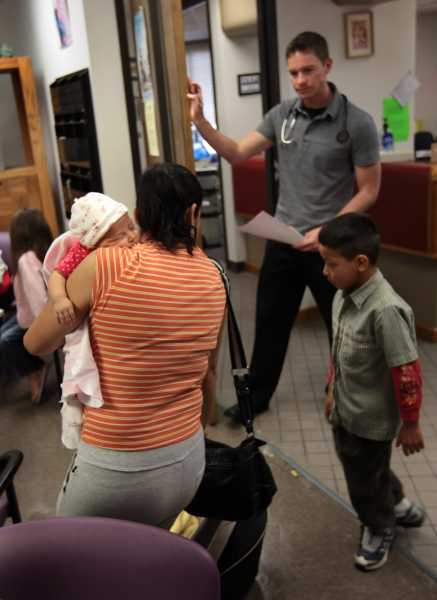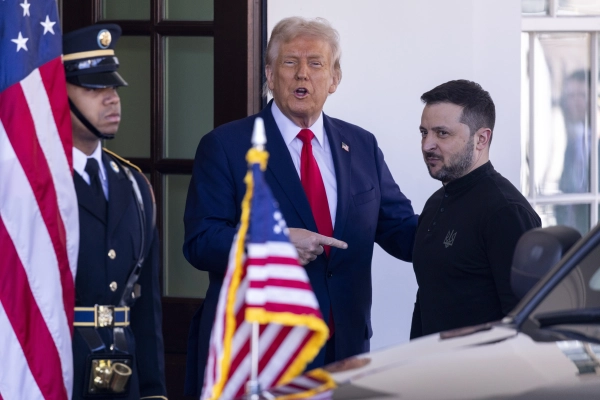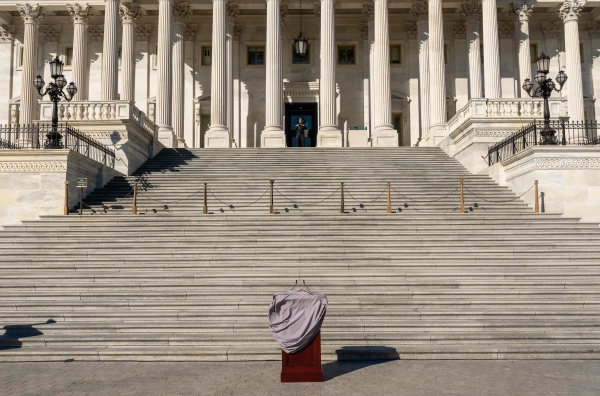
Two federal courts on Friday prevented the Trump administration from implementing a rule that would have created new barriers to low-income immigrants seeking to enter the US. But the rule, which has been anticipated for months, has already stoked fear in immigrant communities that court rulings are unlikely to quell.
The rule, published in August by the Department of Homeland Security and originally scheduled to go into effect October 15, would establish a test to determine whether an immigrant applying to enter the US, extend their visa, or convert their temporary immigration status is likely to end up depending on public benefits.
Immigration officials would have much more leeway to turn away those who are “likely to be a public charge” based on an evaluation of 20 factors, ranging from the use of certain public benefits programs — including food stamps, Section 8 housing vouchers, and Medicaid — to English language proficiency. Researchers estimated that it could have affected more than 382,000 people.
Eight federal courts are currently reviewing legal challenges to the public charge rule, and on Friday, three in California, New York, and Washington blocked the rule from going into effect nationwide — for now. (Their decisions might not hold once the Trump administration appeals as expected.)
US District Judge George Daniels called the rule “repugnant to the American Dream of the opportunity for prosperity and success through hard work and upward mobility,” writing in his opinion that there was “zero precedent” for the administration’s attempt to redefine who can’t come to the US through the public charge stipulation.
“Immigrants have always come to this country seeking a better life for themselves and their posterity,” he wrote. “With or without help, most succeed.”
Trump, however, has laid out a very different vision of immigrants’ prospects upon their arrival in the US. He has justified the rule as a means of ensuring that immigrants are “financially self-sufficient” and to “protect benefits for American citizens.”
“I am tired of seeing our taxpayer paying for people to come into the country and immediately go onto welfare and various other things,” Trump said when announcing the rule. “So I think we’re doing it right.”
Friday’s court rulings rejected the ideas behind these policies with the strongest possible language. But whether or not they are upheld on appeal, the rule has had a chilling effect already: Noncitizens have been needlessly dropping their public benefits at alarming rates for fear that they will face immigration consequences.
Many immigrants aren’t eligible for public benefits and not all public benefits are available to noncitizens. In the majority of cases, the best advice for immigrants is to keep using the programs to which they’re entitled, even if the rule eventually goes into effect, Doug Rand, a former White House official who worked on immigration policy in the Obama administration, said.
But for many immigrants who have already decided to drop their benefits, that advice is coming too late. The publicity surrounding the rule — and particularly more sweeping early drafts — has already accomplished what the Trump administration wanted: Immigrants are being driven away from public benefits. Even if the rule never goes into effect, in that sense, it’s already succeeded.
“Give me your tired and your poor who can stand on your own two feet”
The rule fits in with one of the broader ideas guiding Trump’s immigration policy: that immigrants take advantage of public assistance without offering the US anything in return. It would enact the philosophy that acting US Citizenship and Immigration Services Director Ken Cuccinelli once described, amending Emma Lazarus’s famous poem on the Statue of Liberty: “Give me your tired and your poor who can stand on their own two feet.”
It also will make getting into the US much harder for immigrants sponsored by family members, the phenomenon Trump has excoriated as “chain migration.”
The rule was only one of several policies the Trump administration has enacted to dramatically shift which immigrants are legally able to come to the United States. Trump issued a proclamation earlier this month barring immigrants who do not have health insurance and cannot afford to pay medical care costs from getting visas of almost any kind to enter the US.
He issued another executive order in September allowing states that do not have the resources to support refugees in becoming “self-sufficient and free from long-term dependence on public assistance” to turn them away. And the Department of Housing and Urban Development also proposed a rule in May that would allow the agency to evict families in which at least one person is an unauthorized immigrant from public housing — an estimated 108,000 people.
But while the Trump administration paints immigrants as abusing public benefits, immigrants are actually “less likely to consume welfare benefits and, when they do, they generally consume a lower dollar value of benefits than native-born Americans,” according to the Cato Institute, a libertarian think tank.
In 2016, the average per capita value of public benefits consumed by immigrants was $3,718, as compared to $6,081 among native-born Americans. They were slightly more likely to get cash assistance, SNAP benefits and Medicaid, but far less likely to use Medicare and Social Security.
“The rhetoric around the use of public benefits programs is largely smoke and mirrors,” Erin Quinn, a senior staff attorney at the Immigrant Legal Resource Center, said in an interview. “It’s feeding a rhetoric that immigrants are draining our public services when in fact these immigrants don’t even have access to those services and also galvanizing fear in immigrant communities.”
The “public charge” rule, explained
The US has been able to reject prospective immigrants who are likely to become a “public charge” — dependent on the government for support — since 1882, but since World War II, few immigrants were turned away using that criteria. In 1999, the Clinton administration issued guidance that said only cash benefits, which very few immigrants use, would be considered in making the determination.
The Trump administration sought to define “public charge” much more broadly, giving immigration officials at US Citizenship and Immigration Services and US Customs and Border Protection a laundry list of factors to consider. And it would allow individual immigration officials to implement this complicated, 217-page regulation as they see fit.
The rule would give individual, low-level officials much more vetting power than they have now, and inject a lot of uncertainty into the green card process. It could have a significant impact on who is allowed to enter and remain in the US as a lawful permanent resident.
But the final version of the regulation is much less stringent than earlier versions that were leaked to the public (including one to Vox). Those drafts would have allowed immigration officials to consider immigrants’ use of a long list of federal public benefits programs, including CHIP and Head Start, the federal early childhood education program. It also would have looked at any programs used by an immigrant’s household — meaning that immigrants could be penalized if they sought benefits for their children instead of themselves.
Early reports raised the alarm about how the rule targeted immigrants on public benefits. The Trump administration got hundreds of thousands of comments about it. And immigrants started dropping out of those programs, worried that their chances of getting a green card or citizenship would be affected.
An Urban Institute study found that, based on a survey of about 2,000 adults in immigrant families, 13.7 percent of them said that they or one of their relatives chose not to use non-cash benefits programs in 2018 as a result of reports about the rule. Eventually, the rule could lead up to 4.7 million people to withdraw from Medicaid and the Children’s Health Insurance Program (CHIP) alone, according to a report by the Kaiser Family Foundation.
The Los Angeles Times reported that some immigrants with children enrolled in special education programs withdrew them from school and that refugees and asylum seekers dropped out of food assistance programs.
Quinn said that her organization has found that immigrants are also avoiding applying for asylum and citizenship, even though the final version of the rule does not affect either process.
“The rule has falsely created an impression that undocumented immigrants and temporary residents are gobbling up public benefits, which they’re not because they’re generally not eligible,” Rand said. “And it has scared those who are eligible, who are primarily permanent residents with green cards, legal immigrants, into unenrolling from programs they are perfectly eligible to take advantage of under the law.”
Damage from the rule has already been done
Some federal programs are eligible to all immigrants regardless of status, including the National School Lunch Program; the Special Supplemental Nutrition Program for Women, Infants, and Children (WIC); and Head Start. Some immigrants can also become eligible for Social Security benefits and Medicare in old age.
But “means-tested welfare programs” — federal public benefits for those in poverty including Medicaid, CHIP, the Supplemental Nutrition Assistance Program (SNAP), Temporary Assistance for Needy Families, and Supplemental Security Income (SSI) — are primarily reserved for naturalized and US-born citizens, green card holders, refugees, and asylees.
Unauthorized immigrants and most people with temporary immigration status, such as employment-based visas, are ineligible, and green card holders have to wait for five years before becoming eligible (although some states give them access earlier).
All of this means that relatively few immigrants would end up being penalized, under the final version of the rule, for using public assistance. But the rule has already been effective in dissuading many immigrants from continuing to access the public benefits they need.
Reporting about the potentially drastic effects of the rule, and advocacy groups’ decision to condemn it, all helped spread the word. Most immigrants will face no consequences for keeping their benefits, Rand said. But advocates and attorneys are reluctant to make any such blanket statements for fear of being responsible for giving bad advice, particularly if the rule does go into eventually go into effect.
“Unfortunately, I think a lot of the damage has already been done through the rhetoric and the media cycles around the various proposals,” Quinn said. “The erratic policymaking of this administration means that many are afraid of hanging their hat on any legal outcomes that comes out of the litigation or even the fact that the rule isn’t yet in effect.”
DHS’s cost-benefit analysis of the rule is premised on the fact that many people will unnecessarily unenroll from public benefits or refrain from enrolling from such programs in the future, Rand said. The economic gains the department cited in its analysis are almost entirely attributable to the anticipated reduction in “transfer payments,” or government payments to public benefits recipients.
“In other words, the ‘chilling effect’ isn’t a second-order consequence of the rule; according to DHS, it’s practically the only thing that makes the rule economically beneficial,” Rand said.
Friday’s district court rulings argue that the public charge rule conflicts with how federal immigration law has been interpreted for two decades and appears to ignore the tens of thousands of public comments that opposed it.
“Defendants do not articulate why they are changing the public charge definition, why this new definition is needed now, or why the definition set forth in the Rule—which has absolutely no support in the history of U.S. immigration law—is reasonable,” Judge Daniels wrote in his opinion.
The administration is likely to appeal federal court decisions imminently, so this isn’t the end of the road for the legal battle over the rule.
There’s also a companion rule at the State Department, introduced on October 10 and almost identical to the one at DHS that was blocked on Friday, that an agency spokesperson confirmed is still scheduled to go into effect October 15. If it stands, it affects a much broader population — about 13 million visa and green card applicants annually, Rand said.
That means that, barring any court orders in the next few days, immigrants can be denied new visas or green cards at consulates abroad under the Trump administration’s 20-factor public charge test. The rollout of this could be messy, given that the State Department has yet to issue any guidance on how to implement the rule for its consular officers charged with evaluating applicants.
Immigration lawyers are skeptical, however, that the State Department’s rule can be implemented so long as the parallel one at DHS is blocked.
“You would hope that after three separate federal judges declared that the administration’s definition of public charge is a violation of the law, the State Department wouldn’t move forward with the rule,” Aaron Reichlin-Melnick, a policy analyst at the American Immigration Council, said. “But that’s what they’re doing.”
Sourse: vox.com






